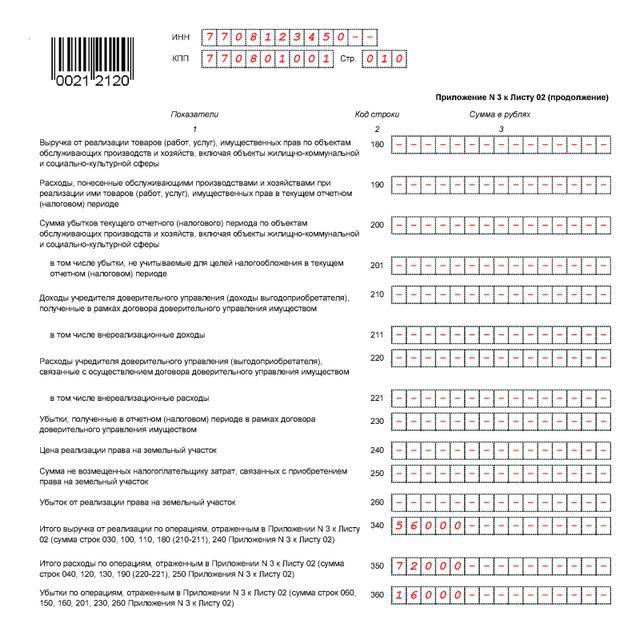The main focus of the tax service is to control the timeliness of deductions established by the Tax Code. Supervision is carried out in various ways. Including verification income tax returns. Loss in This document draws special attention of tax authorities. They are entitled to send an economic entity a request for clarification on the situation. 
Consider further what may be consequences of the loss in the income tax return for the year and how to avoid them.
A few words about the deduction
As you know, the tax law provides for two types income tax. Kbk, respectively, in the declaration are different.
Mandatory payment from the proceeds of the enterprise may be paid to the federal and regional budgets. In the first case KBK income tax it will be like this: 182 1 01 01011 01 1000 110, in the second - 182 1 01 01012 02 1000 110.
Tax Rights
Upon identification loss in income tax return supervisory authorities may:
- Request clarification.
- Invite to the commission.
- Include the subject in the field inspection plan.
Undoubtedly, any of the actions taken does not bring anything pleasant for the enterprise.
"Unprofitable declaration"
There is no profit tax amount in this report. This situation occurs when the company has not received economic benefits from its activities.
Loss in income tax return call the negative difference between revenues and costs that must be accounted for the purposes of taxation.
Relevance of the issue
Tax authorities often show increased attention to unprofitable enterprises. The occurrence of a negative difference between revenues and expenses is regarded by the control authorities as a sign of the commission of certain tax offenses: from evading payment of mandatory payments to intentional bankruptcy and fraud. 
INFS actions upon receipt of a loss-making report
If a loss is identified, the control body:
- She contacts the company’s management by telephone and asks for comment on the current situation.
- Directs an employee to the organization.
- Sends a written request.
Refuse to give explanation of loss in the income tax return for the year the enterprise is not entitled. Otherwise, the IFTS takes more stringent measures, including a full-scale comprehensive audit of the organization.
Report loss
After summing up the annual work and identifying the loss, the enterprise management can go in several ways. One option is to reflect the actualbull in the income tax return.
Accordingly, management should be prepared to respond to all inquiries that come from the IFTS. It should be said that no more than 5 days are allowed for an answer.
Experts recommend as much as possible to describe all their costs, explain the reasons why such an unsatisfactory result has arisen. It is advisable to present a plan for the enterprise to overcome the situation.
Preconditions for Losses
The following circumstances may be cited in the explanations:
- Lack of revenue from the sale of products or insufficient revenue. This reason is usually indicated by newly created enterprises or companies with a long production cycle.
- Development of new sales territories.These events, of course, require significant investments: market monitoring, a business plan, etc. are required.
- Drop in demand, seasonality of sales. These factors significantly affect the cost of production. Lower demand tends to lower prices.
- Decrease in sales. This can happen due to the loss of large customers.
- Significant one-time expenses during the control period. For example, the enterprise had a need to purchase new equipment and carry out overhaul of the premises.
- Force Majeure. Unforeseen circumstances are different. For example, a warehouse was flooded, a store burned out, etc.
Before how to fill out income tax return, in which the loss will be reflected, it is advisable for the head to draw up immediately written explanations for the IFTS. Of course, if possible, documents should be collected confirming certain circumstances. 
Call to commission
As a rule, an enterprise receives it if it submits a loss-making declaration for more than 2 consecutive years.
The head of the organization is called to the commission. However, the interests of the enterprise may be represented by another person authorized by the directors. As a rule, this is the chief accountant. However, it is more advisable to visit the commission and the head and financial specialist. The presence of a lawyer will also be useful.
At the commission, tax officials will ask questions regarding the direct activities of the company. They mainly relate to financial and business operations. The accountant should not have difficulty answering them. However, the specialist may not understand the legitimacy of the questions asked. For such cases, you need a lawyer.
Experts recommend building a constructive conversation with the tax authorities. If an enterprise, for example, has recently been operating in the market, then large expenses can be associated with advertising and marketing research, which are necessary to develop a certain niche. In addition, a start-up company needs equipment to create products that also cost a lot of money. If the company has long existed, then the drop in revenue can be explained by the need to modernize or replace the OS.
In any case, you need to assure the IFTS that things will go uphill in the near future, and new income tax return will no longer be unprofitable.
Important indicators
When checking income tax returns for the year IFTS analyzes:
- The structure of revenues and expenses of the categories “ordinary” and “other”. The most unfavorable, according to inspectors, are indicators of a high growth of expenses for the main types of activity in comparison with the rate of increase in income. In addition, tax authorities pay special attention to losses due to non-operating losses.
- Balance sheet indicators. The amount of equity capital of the enterprise, according to employees of the IFTS, should be higher than borrowed. The growth rate of current assets should exceed the rate of increase in non-current assets, and the growth in accounts payable and receivable should be approximately at the same level.
- Solvency of the company. The main indicators of insolvency include the lack of sufficient funds for the settlement account, the presence of overdue debts.
If the organization submits a loss-making declaration, respectively, income tax advance payments they don’t enter the budget, since the total amount of the deduction is zero. In such situations, the Federal Tax Service will be interested, first of all, with what means the enterprise exists. In this regard, the manager and accountant must be prepared for the fact that they will have to provide information about the sources of financing. It can be loans, loans, cash receipts from the owner. 
If employees of the Federal Tax Service Inspectorate are interested in any papers, company representatives should not immediately fulfill the request. It is more advisable to invite inspectors to issue an official request.
Reflection of profit in the presence of actual loss
Some managers decide to rid themselves of the challenges and increased attention of the IFTS. They decide to pay tax anyway. However, in this case, a new question arises: how to fill out a profit tax return in the presence of actual loss?
Adjustment of the report can be carried out by increasing income or reducing (increasing) expenses. Next, we briefly consider the main solutions to the problem.
Write-off of reserves
This method is used if the company created such reserves. Normally, this option is provided for in paragraph 7 of article 250 of the Tax Code. Explanations for its use are given in the Letter of the Ministry of Finance No. 03-03-05 / 3/55 of 2004.
For small businesses, cancellation of doubtful debts will lead to an increase in non-operating income.
"Detection" of unaccounted objects
At the end of the year, all enterprises carry out an inventory. It is the most suitable moment for the "discovery" of some unaccounted property. The object is reflected in non-operating income of the current year at the market price.
This option can be used if, of course, the property is at the enterprise.
Check payable period
Not only property is subject to inventory, but also debts. When revealing overdue debts, the manager’s order to be written off is drawn up. 
This option is used in accordance with paragraph 18 of Article 250 of the Tax Code, paragraph 78 of the Regulation on Reporting and Accounting, approved by order of the Ministry of Finance No. 34n of 1998.
Customer Interaction
One of the most harmless ways to adjust the declaration is considered to be an appeal to customers asking them to sign acts of acceptance of part of the work performed in December of this year. Partners who want to increase costs by reducing profits, of course, will agree to this.
In this case, one should be guided by the provisions of the first paragraphs of 248, 249, 271 articles, as well as paragraph 2 318 of the Tax Code.
Contribution from a participant to the property of LLC
It can be provided in money, property rights, things. It should be noted that in this case we are not talking about a contribution to the authorized capital. The cost of revenue forms non-operating income.
Guided by the reflection of the contribution follows paragraphs 1, 3 and 4 of 27 articles of the Federal Law No. 14.
Expense adjustment
For convenience, the most common options are shown in the table:
Way | Explanations | Reference to a regulatory act |
Exclusion of doubtful costs. | When using this option, no effect will be made on the VAT deduction. In addition, the accuracy of the information in the declaration will be retained. | |
Identification of costs that can be taken into account later. | The company may refuse to increase ratios and depreciation premiums. | Articles 258 (paragraph 91, 13) and 259.3 of the Tax Code. |
Recognition of part of expenses as expenses of upcoming periods. | In this case, the company will overpay the tax. In this case, there will be a constant difference between tax and accounting. | 272 article, clause 1. |
Recommendations
Of the options for solving the problem presented above, some methods are less, others are more risky, some relate exclusively to tax accounting information, while others increase revenues from financial statements. However, in any case, it is necessary to make an informed decision and coordinate it with management. 
Meanwhile, lawyers do not recommend adjusting income, but reflecting information in accordance with the real situation. Reliable and timely information is of particular practical importance for management accounting. Based on this information, the enterprise management can analyze real indicators related to profit not only within one specific period, but also between them.
In addition, any commercial activity carries a risk: no one is insured against losses. Accordingly, the IFTS cannot apply any sanctions to the company for losses incurred, if they are justified and are not associated with illegal actions.In such situations, the main thing is not to shy away from answering tax authorities' requests, to give them a transcript of the indirect and direct costs of the company.
Deadlines
Income tax documentation is handed over at the end of each reporting period. It can be a quarter, 6 or 9 months. If the company deducts income tax advance payments every month, then reporting is submitted monthly.
The declaration must be submitted before 28 days from the end of the reporting period.
The table shows the dates by which income tax reporting should be provided.
Period | Quarterly advance | Monthly advance |
January | - | 28.02 |
February | - | 28.03 |
March | - | 28.04 |
1st quarter | 28.04 | - |
April | - | 29.05 |
May | - | 28.06 |
June | - | 28.07 |
Half year | 28.07 | - |
July | - | 29.08 |
August | - | 28.09 |
September | - | 30.10 |
9 months | 30.10 | - |
October | - | 28.11 |
November | - | 28.12 |
December | - | - |
The annual reporting for 2017 is submitted until 03/28/2018.
Income Tax Return Form
The basic reporting rules are as follows:
- The declaration is filled in cumulatively from the beginning of the year.
- Information is indicated from left to right from the first cell. If the familiarity remains blank, a dash is put in it.
- When entering information using a computer, the numerical indicators are aligned to the right.
- Values are indicated in full rubles, guided by the rules of rounding.
- At the top of the report is the PPC and TIN of the enterprise.
- Each page should have a serial number.
- Fill out the declaration in black, blue or purple ink.
- Correction of data by special (corrective) devices and means, stitching, fastening of sheets, indicating information on both sides of the sheet are not allowed.
The annexes to the income tax return are executed in accordance with the Procedure approved by the order of the Federal Tax Service of 10.19.2016. 
A responsibility
Fines may be imposed on business entities that fail to submit a timely declaration:
- 1 thousand rubles - if the head of the report was not submitted, but the tax was deducted on time, or if the “zero” declaration was not submitted on time.
- 5% of the amount that should be credited to the budget for each month of non-payment, but not more than 30% and not less than 1 thousand rubles.
- 200 rub - in case of untimely submission of calculation (declaration) at the end of the reporting period.
It should be said that declarations submitted at the end of the year are, in fact, considered tax calculations. Accordingly, the supervisory authority cannot impose a fine on an economic entity under Article 119 of the Tax Code if it has not been provided with a profit tax calculation. A monetary penalty may be imputed solely according to 126 norms of the Code.